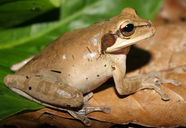|
Description
Smilisca phaeota is a relatively large hylid frog with adult size reaching up to 78 mm (Leenders 2001). This frog can be easily be distinguished, since it is the only large tree frog in Costa Rica that has both a silvery white stripe on the upper lip and a dark, masklike stripe from the nostril to the insertion of the arms (Guyer 2005). Many individuals have a green spot on each side of the head between the dark mask and the lip (Leenders 2001). Coloration can range from pale green to tan, and the frog may either be uniform in color or have dark olive green to dark brown dorsal blotches (Savage 2002). It has a relatively flattened body (Leenders 2001), and a smooth dorsal surface (Savage 2002). The head is as wide as it is long, with a snout that is bluntly rounded from above (Savage 2002). It has skinlike webbing between the toes and fingers and an enlarged disk on each finger that is adhesive. The eardrums (tympana) are visible. The eyes are large, with horizontal elliptical pupils and copper colored irises (Leenders 2001).
Smilisca phaeota is capable of changing color. It can change the color of its upper surface to tan or green. They are usually tan during the day and change to green during the night (Leenders 2001).
Similar species include: 1) Smilisca baudinii, which differs from S. phaeota by the former's lack of reticulate flanks and white stripes on the lip, forearm, and leg; 2)Smilisca puma, which is smaller and has little or no webbing (Savage 2002). Distribution and Habitat
Country distribution from AmphibiaWeb's database: Colombia, Costa Rica, Ecuador, Honduras, Nicaragua, Panama
Smilisca phaeota can be found in the Caribbean slopes from Honduras to northern Colombia and the Pacific slopes from Costa Rica to Ecuador (Guyer 2005). It primarily inhabits lowland rainforest, up to 3,300 ft in elevation (Leenders 2001). It is common in areas disturbed by humans, such as storm drains and around laboratory buildings (Guyer 2005).Life History, Abundance, Activity, and Special Behaviors
These frogs are mainly active during the night and throughout the wet season (Savage 2002). During the day, they sleep on the upper surface of large leaves, but have also been found sleeping on top of large tree ferns or in rolled-up banana leaves. In the mating season, males produce a loud and harsh "wrauk" at dusk. They call from the water surface of small rain pools. Females lay small clumps of up to 2,000 eggs to form a small thin layer on the water surface. Since females lay their eggs in small rain pools, tadpoles must develop rapidly to avoid desiccation (Leenders 2001).
This frog presumably preys on arthropods (Guyer 2005).
Larva
Tadpoles are moderately sized and can reach 30 mm in length. They have a robust body, anteroventral mouth, dorsolateral nostrils, dorsolateral eyes, lateral spiracle, and a rounded tail tip (Savage 2002). Trends and Threats
These frogs are common (Savage 2002).
References
Guyer, C. (2005). Amphibians and Reptiles of La Selva, Costa Rica, and the Carribean slope. University of California Press, Berkeley.
Guyer, C., and Donnelly, M. A. (2005). Amphibians and Reptiles of La Selva, Costa Rica and the Caribbean Slope: A Comprehensive Guide. University of California Press, Berkeley.
Leenders, T. (2001). A Guide to Amphibians And Reptiles of Costa Rica. Zona Tropical, Miami.
Savage, J. M. (2002). The Amphibians and Reptiles of Costa Rica:a herpetofauna between two continents, between two seas. University of Chicago Press, Chicago, Illinois, USA and London.
Originally submitted by: Peera Chantasirivisal (first posted 2000-01-18)
Edited by: Kellie Whittaker, Michelle S. Koo (2023-01-02)Species Account Citation: AmphibiaWeb 2023 Smilisca phaeota: Masked Tree Frog <https://amphibiaweb.org/species/1166> University of California, Berkeley, CA, USA. Accessed May 30, 2025.
Feedback or comments about this page.
Citation: AmphibiaWeb. 2025. <https://amphibiaweb.org> University of California, Berkeley, CA, USA. Accessed 30 May 2025.
AmphibiaWeb's policy on data use.
|
